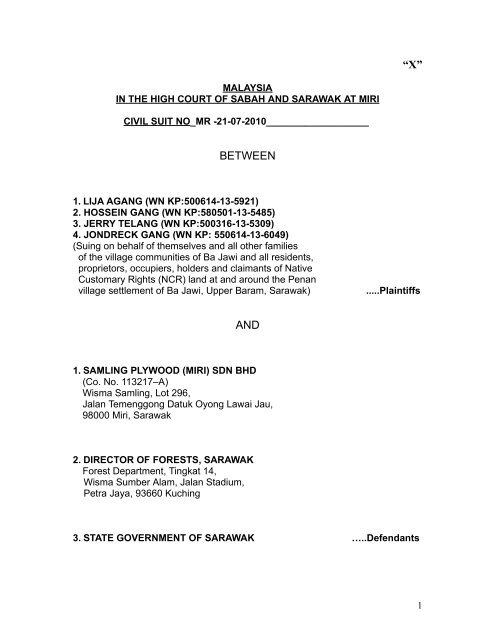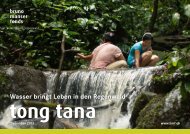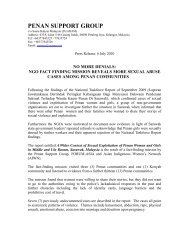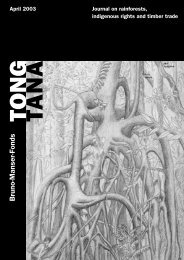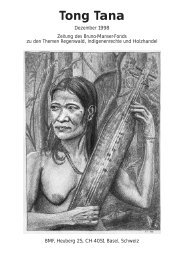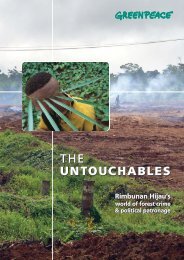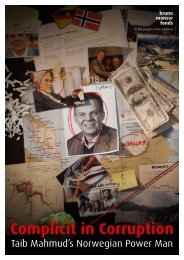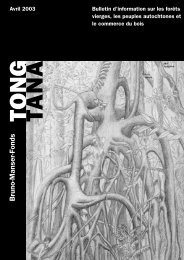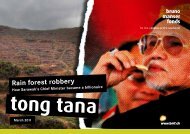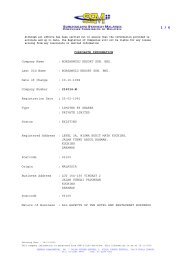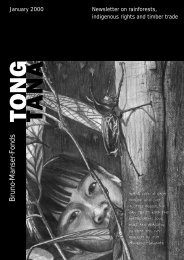statement of claim
statement of claim
statement of claim
Create successful ePaper yourself
Turn your PDF publications into a flip-book with our unique Google optimized e-Paper software.
“X”MALAYSIAIN THE HIGH COURT OF SABAH AND SARAWAK AT MIRICIVIL SUIT NO_MR -21-07-2010___________________BETWEEN1. LIJA AGANG (WN KP:500614-13-5921)2. HOSSEIN GANG (WN KP:580501-13-5485)3. JERRY TELANG (WN KP:500316-13-5309)4. JONDRECK GANG (WN KP: 550614-13-6049)(Suing on behalf <strong>of</strong> themselves and all other families<strong>of</strong> the village communities <strong>of</strong> Ba Jawi and all residents,proprietors, occupiers, holders and <strong>claim</strong>ants <strong>of</strong> NativeCustomary Rights (NCR) land at and around the Penanvillage settlement <strong>of</strong> Ba Jawi, Upper Baram, Sarawak).....PlaintiffsAND1. SAMLING PLYWOOD (MIRI) SDN BHD(Co. No. 113217–A)Wisma Samling, Lot 296,Jalan Temenggong Datuk Oyong Lawai Jau,98000 Miri, Sarawak2. DIRECTOR OF FORESTS, SARAWAKForest Department, Tingkat 14,Wisma Sumber Alam, Jalan Stadium,Petra Jaya, 93660 Kuching3. STATE GOVERNMENT OF SARAWAK …..Defendants1
STATEMENT OF CLAIMParties1 (a) The Plaintiffs are Penans by race and are therefore, natives <strong>of</strong>Sarawak.(b)The Plaintiffs bring this action on behalf <strong>of</strong> themselves and all otherresidents <strong>of</strong> the Penan village communities <strong>of</strong> Ba Jawi asoccupiers, proprietors, holders, beneficiaries and <strong>claim</strong>ants <strong>of</strong>native customary rights (NCR) land at and around Ba Jawi, UpperBaram, Sarawak.2.1 The 1 st Defendant is a company incorporated in Malaysia under theCompanies Act 1965 with a registered address at Wisma Samling, Lot296, Jalan Temenggong Datuk Oyong Lawai Jau, 98000 Miri, Sarawakand a principal nature <strong>of</strong> business in the manufacture and/or sale <strong>of</strong>plywood, and/or the extraction and/or sale <strong>of</strong> timber. A Re-Entry HillLogging Timber Licence No. T/0413 (hereinafter, ‘the said timberlicence’) was issued to it by the 2 nd Defendant to harvest merchantabletimber over a licenced area in the Upper Baram district. The timber licencewas issued in September 1993 and will expire in August 2018.2.2 The 2 nd Defendant is at all material times and for all purposes, the servantand/or agent <strong>of</strong> the 3 rd Defendant whose <strong>of</strong>ficial address is at 14 th Floor,Wisma Sumber Alam, Jalan Stadium, Petra Jaya, 93660 Kuching,Sarawak and <strong>of</strong> whose <strong>of</strong>ficial duty and responsibility includes inter alia,the grant and/or issuance <strong>of</strong> timber licences.2.3 The 3rd Defendant is the sovereign government <strong>of</strong> Sarawak state withinthe Federation <strong>of</strong> Malaysia, and is at all material times and for allpurposes, the employer and/or principal <strong>of</strong> the 2 nd Defendant.The Penan community <strong>of</strong> Ba Jawi3. The Plaintiffs share the same ancestry as the Penans <strong>of</strong> settlements inLong Lamai, Ba Lai and Long Beruang.3.1 About 200 years ago, or as far back as the Penans can recall <strong>of</strong>their oral history, the ancestors <strong>of</strong> the Plaintiffs and the Penans <strong>of</strong>settlements in Ba Jawi, Long Lamai, Ba Lai and Long Beruang andgenerally the Penans who are now settled in the Upper Baram,were living in and around Ba Jawi, practicing the native customary2
ights over the land in Ba Jawi and the vicinity. They hunted andgathered food from the forests and lived on sago (uvut) as theirstaple food. The plaintiffs are presently practicing these rights overthe same land.3.2 As far as the Plaintiffs can recall, the earlier leaders <strong>of</strong> theirnomadic Penan tribe were Opo Munyai, Opo Peniyiban, OpoJaleng, Opo Muai, Opo Sawen, Opo Tevu, Opo Luti, and OpoNuhun.3.3 By and through their customary practice most characterized bymolong, tribal groups <strong>of</strong> the nomadic Penan lived in and withindistinct territories. Traditional dwelling huts called lamin toro wereleft behind as distinct marks <strong>of</strong> earlier settlements.3.4 When the Penans developed the system <strong>of</strong> setting up satellite sagoharvesting camps, they started to be semi-nomadic, about 100years ago.Ba Jawi4. The present headman <strong>of</strong> the Ba Jawi Penans, Lija Agang, is a directdescendant <strong>of</strong> Opo Munyai and Opo Penyiban. He succeeded his father,Agang Ngiung when the latter passed away. In turn, his father succeededBangau as the headman. Since the time <strong>of</strong> Opo Munyai, the Ba JawiPenans have settled in the watersheds <strong>of</strong> Baram River, mostly alongSungai Jawi. Opo Munyai was succeeded by Opo Peniyiban as headman<strong>of</strong> the Ba Jawi Penans.Headman Agang Ngiung was born on the Kara River, a sub-tributary <strong>of</strong>the Jawi River where he raised his family with his wife, Julan Upa. Sagopalm trees on the right side <strong>of</strong> the river mouth <strong>of</strong> Kara River were used toproduce uvut, a sago starch staple <strong>of</strong> the Ba Jawi Penans. These sagopalm trees are still found today at Kara River.The Ba Jawi Penans bury their dead in their ancestral land, along theconfluence <strong>of</strong> streams or small rivers and identified to be at Upper Nyoke,Ma’ut, Lamah and Likam, all being sub-tributaries <strong>of</strong> the Jawi and BuangRivers.The Selaba and Buang River areas were the location where the Plaintiffsand their ancestors roamed to hunt and collect and harvest jungleproduce. In addition, the Plaintiffs’ ancestors had roamed the forests to asfar as the Moh, Pelutan and Selungo Rivers. In their sojourns, they metand befriended the Kayans and Kenyahs.3
Movements in and around Ba Jawi and to locations outside it is by aseries <strong>of</strong> trekking pass, naturally identified and named as Sawa Anau,Sawa I’ot Ba Penan Silat and Sawa Lakat Nebak.The tamu meetings <strong>of</strong>ten attended by the Ba Jawi Penans were at LioMato, Upper Baram where goods brought by the Penans were traded withnecessities and other goods brought by other indigenous tribes.After the Second World War, the Ba Jawi Penans embraced Christianityby the effort <strong>of</strong> White man missionaries. The Ba Jawi Penans do not knowthe names <strong>of</strong> these missionaries and they were given and known by theirPenan names as Pendita Panai and Pendita Lalung.Before the Ba Jawi Penans were settled in villages by the British ColonialAdministration, the Penans were roaming the jungles <strong>of</strong> the Upper Baramin search <strong>of</strong> wild sago, jungle produce, wild animals, rubber and other wildproducts for sustenance and sale. They enjoyed good relations with theBritish administration, that regularly invited them to the tamu at Lio Mato,Baram, Sarawak.When settled in their original land, the Ba Jawi Penans were able to plantvarious food and cash crops and raise livestock for community use andsale. However, to-date, the Ba Jawi Penans still practices their ancestors’lifestyle such as hunting in the jungles <strong>of</strong> Upper Baram for weeks ormonths in search <strong>of</strong> forests produce..Native Customary Rights over Land5. At all material times, the Plaintiffs have acquired and <strong>claim</strong>ed nativecustomary rights (“NCR”) and/or native title and/or usufructuary rightand/or territorial domain locally referred to and known as “Tana Pengurip”over an area <strong>of</strong> land bordered by the following boundary with physicalground markings referred and known to the Plaintiffs and theirneighbouring village communities as their ancestral or NCR land (“NCRLand”) <strong>of</strong> Ba Jawi, Upper Baram, Sarawak.Particulars“Tana Pengurip” <strong>of</strong> Ba Jawi4
The boundary <strong>of</strong> Ba Jawi begins at the river Ba Buang, right after theconfluence <strong>of</strong> a small stream called Ba Nyivung. From there the boundaryascends and follows a small mountain ridge called Tokong Lesuan to thetop <strong>of</strong> a mountain called Berusu Batang Kapon. From there it continues upon the same mountain ridge and stretches further up to a mountain calledBerusu Bateu.Following the mountain ridge, the boundary leads up to a mountain peakcalled Berusu Payah. It then descends on Berusu Payah, and crosses theBa Ulang river right after the confluence <strong>of</strong> (Long) Ba Lamin Telang andascends the mountain ridge until it reaches a pass called Sawa I’ot BaPejanan.Then the boundary follows a mountain ridge along the watersheds <strong>of</strong> BaUlang and Ba Pejanan rivers until the summit <strong>of</strong> Berusu Lamin Kerotong.Then it follows the mountain ridge to a pass called Sawa Tupi. Furtheraway is another mountain ridge called Berusu Bua Kung, and then,following this mountain to Sawa Batang Kapon, until it reaches BerusuAlim. In passing through Berusu Alim, the boundary line will reach BerusuTeva’un.Next, following a mountain called Tokong Patah Ja’au, it will reach SawaLakat Alim, before passing through Berusu Melete to Sawa Asa Bila’. Itthen extends up to the next mountain called Tokong Bolo Aput to passthrough Sawa Lakat Nebak and then onto Berusu Uvut. From there, it willpass through Sawa Lamin Tetong to eventually reach a mountain ridgebetween Indonesia and Malaysia, known as Tokong Toto.Before reaching Tokong Toto, the boundary crosses a summit calledBerusu I’ot Ba Jawi, and then to Berusu I’ot Ba Buang, and finally toBerusu Tokong Ja’au, in order to reach Sawa Anau and Berusu Anau. Theboundary line then goes on to Berusu I’ot Ba Tabo, after passing through5
Sawa I’ot Ba Tabo. From Tokong Toto, the boundary continues to BerusuIliu and Sawa Bateu Mengot. It continues on until it eventually reachesSawa I’ot Ba Peresek, before it proceeds to Sawa I’ot Ba Batang Maha, toreach Berusu Uvut Ja’au. Then it continues down to Berusu Buang, andthereon to a mountain called Tokong Uvut until it reaches the peak, knownas Berusu Datee Tivang. It will then stretch upwards to another mountainridge called Berusu Anak Buang, before descending the ridge to end atthe point <strong>of</strong> origin at Ba Nyivung.The boundary or extent <strong>of</strong> the said ancestral or NCR Land <strong>of</strong> Ba Jawi is asreflected on the map marked “M” and annexed hereto.6. The Plaintiffs’ ancestors had roamed and/or occupied all the areas withinthe said Tana Pengurip and/or NCR Land since time immemorial until the1950s, when they decided to settle at the present location <strong>of</strong> their villagesettlement <strong>of</strong> Ba Jawi. The Plaintiffs <strong>claim</strong> NCR over the said TanaPengurip as the home for the Penans or NCR Land by virtue <strong>of</strong> theiradat or customs and/or adat or customs <strong>of</strong> the Penans <strong>of</strong> Sarawak. ThePlaintiffs have never abandoned their NCR over the said NCR Land andthey have lived and/or settled within the said Tana Pengurip or NCR Landsince their ancestors prior to the installation <strong>of</strong> the 1 st Rajah as the Rajah<strong>of</strong> Sarawak, in the year 1841.6.1. In accordance with the Plaintiffs’ customs and practice, theirancestors and themselves prior to their decision to have a settledlifestyle in the 1950s, the Plaintiffs roam the areas <strong>of</strong> their said NCRLand along a distinct route and within a distinct territorial confine insearch for jungle produce and games. The areas <strong>of</strong>ten andfrequently visited were the areas named in paragraph 5,hereinabove. The Plaintiffs lived in the same locality in the presentsettlement and it has become their home from which they madetrips to the surrounding forests, in search for daily foods, in the saidTana Pengurip and/or NCR Land.6.2. During the later years <strong>of</strong> the Rajahs (1841-1942), the Plaintiffs’ancestors were already in contact with other indigenous groupsfrom other villages and settlements in the Upper Baram. Thecontact between the Plaintiffs’ ancestors and the Rajahs and theBritish Empire were conveyed through native <strong>of</strong>ficials appointed bythe Rajahs’ government.6
6.3. The Plaintiffs’ ancestors and/or themselves had barter traded withother indigenous groups from other villages and settlements withgoods such as Nyateng (resins to obtain fire), stones extractedfrom the stomachs <strong>of</strong> wild animals, Kapon (latex <strong>of</strong> Kapor trees)and handicrafts (mats, baskets, etc.); in exchange for shotguns,clothes for avet (dressing), cooking pots, axes, hatchets and others.The Japanese War <strong>of</strong> 1941-1945 hampered this barter trade. Afterthe said Japanese War, the Plaintiffs and/or their ancestors resumethe barter trade. The Plaintiffs and/or their ancestors havebefriended the British <strong>of</strong>ficers whom they have met and known tothem as Tuan Gelat, Tuan Akat, Tuan Beripin, Tuan Lidam, TuanAdinand, Tuan Tana and Tuan Rick.6.4. That the Plaintiffs have various significant landmarks related tocertain historical incidents within the said Tana Pengurip and orNCR Land that are now evidence <strong>of</strong> their occupation <strong>of</strong> the saidTana Pengurip and or NCR Land as <strong>claim</strong>ed herein. The names <strong>of</strong>the localities as enumerated in paragraph 5 hereinabove, and thehistorical incidents connected or related to these landmarks shallbe disclosed at the trial <strong>of</strong> this action.7. Further and in the alternative, the Plaintiffs shall <strong>claim</strong> that they haveacquired and/or inherited their rights, interests and/or title over the saidTana Pengurip or NCR Land by virtue <strong>of</strong> and under the principle <strong>of</strong> thecommon law.8. The Plaintiffs’ NCR over the said Tana Pengurip and or NCR Land isrecognized by the Sarawak Land Code (Cap.81) and/or its predecessorsand the said NCR was created and/or acquired prior to the 1 st day <strong>of</strong>January1958, and still subsist as such.9. From the said Tana Pengurip and/or NCR Land, that comprises <strong>of</strong>farmland and forests, the Plaintiffs obtain food, valuable medicines, wildlifeand other forest produce, for their livelihood and subsistence. They als<strong>of</strong>arm and cultivate padi, various fruit trees, and other essential food cropson the said Tana Pengurip and/or NCR Land.10. The said Tana Pengurip and or NCR Land is not merely a source <strong>of</strong>livelihood but constitute life itself as the said Tana Pengurip and/or NCRLand is fundamental to the Paintiffs’ social, cultural and spiritual identity asthe native Penan peoples <strong>of</strong> Sarawak.Forest Timber Licence7
11. In and around September 1993, without consultation with the Plaintiffs andunknown to them, the 2 nd Defendant issued the said timber licence to the1 st Defendant, <strong>of</strong> which the licensed areas within the said timber licence, inwhole or in part, encroaches on the said Tana Pengurip or NCR Land <strong>of</strong>the Plaintiffs. Since the issuance <strong>of</strong> the said timber licence, the 1 stDefendant and/or its contractors, subcontractors, employees, servantsand/or agents have been and are working, trespassing and destroying thesaid Tana Pengurip or NCR Land and its constituents, depriving thePlaintiffs <strong>of</strong> their main source <strong>of</strong> livelihood.Timber Licence No. T/041312. Samling Plywood Sdn Bhd’s Re-Entry Hill Logging Timber Licence No.T/0413 was issued by the 2 nd Defendant to the 1 st Defendant to harvestmerchantable timber over a Licenced area measuring about hectares.12.1 The Forest Timber Licence No. T/0413 was issued in September1993 and will expire in August 2018.13. The boundary or extent <strong>of</strong> the said timber licence in the vicinity <strong>of</strong> theTana Pengurip or NCR Land <strong>of</strong> Kampung Ba Jawi overlaps with the TanaPengurip or NCR Land <strong>of</strong> Kampung Ba Jawi as reflected on the mapmarked “L” and annexed hereto.14. The said timber licence was granted without the permission <strong>of</strong> thePlaintiffs, who are the rightful owners and/or proprietors and/or Licenseesand/or <strong>claim</strong>ants to/<strong>of</strong> the said NCR Land.15. The said timber licence was granted for the areas <strong>of</strong> land which includesand comprised <strong>of</strong> farmlands and forest reserves used by the Plaintiffs.16. It is an express provision and/or requirement <strong>of</strong> the said timber licencethat it is granted subject to and/or without prejudice to the Plaintiffs’ rightsincluding the exercise <strong>of</strong> native customary rights over the licensed area.17. Neither the 1 st Defendant nor the logging contractors had conductedground surveys to identify and establish the boundary <strong>of</strong> the said NCRland or land <strong>claim</strong>ed by the Plaintiffs that include burial grounds, historicalsites, sacred sites and/or other significant sites in the licensed area.Plaintiffs’ rights impaired18. The grant and/or issuance and/or registration <strong>of</strong> the said timber licence bythe 2 nd Defendant on the ostensible authority <strong>of</strong> legislation such as theForest Ordinance is unconstitutional and/or wrongful in so far as it8
abridges or impairs the Plaintiffs’ rights and/or title in or over the said TanaPengurip or ancestral or NCR Land for being the source <strong>of</strong> the Plaintiffs’livelihood and for their generations to come.18.1 Since time immemorial the ancestors <strong>of</strong> the Plaintiffs hadestablished and maintained a comprehensive scheme by whichthrough their laws, customs, tradition and practices, havedetermined the questions <strong>of</strong> ownership, land use management andoccupation <strong>of</strong> land, forests and rivers within their said TanaPengurip or ancestral or NCR Land.18.2 By their laws, customs, tradition and practices, they were entitled tothe rights <strong>of</strong> ownership and/or use and/or occupation <strong>of</strong> the saidTana Pengurip or ancestral or NCR Land and access to all theproducts therein, as well as to the hunting grounds and fishingwaters. The Plaintiffs have exercised the aforesaid rights over thesaid Tana Pengurip or ancestral or NCR Land since timeimmemorial until to this day.18.3 Therefore, the Plaintiffs had prior to the enactment <strong>of</strong> the saidlegislation, accrued and acquired vested native customary rightsover the said Tana Pengurip or ancestral or NCR Land.18.4 For the reasons aforesaid, the said accrued rights could not be, andwere never lawfully vested in the state government under article 47<strong>of</strong> the constitution <strong>of</strong> the state <strong>of</strong> Sarawak or howsoever, otherwise.18.5 No timber licence, temporary or otherwise, could therefore beissued over the Plaintiffs’ said Tana Pengurip or ancestral or NCRLand.No Extinguishment Of The Plaintiffs’ NCR19. There was no extinguishment <strong>of</strong> the Plaintiffs’ NCR within the landcovered by the said timber licence before the same were issued and/orgranted to the 1 st Defendant; whereas compensation in accordance withthe Land Code <strong>of</strong> Sarawak and the Federal Constitution is required to bemade or paid to the Plaintiffs to effect such extinguishment. The issuance<strong>of</strong> the said timber licence in such circumstance is therefore unlawful,unconstitutional, and improper and henceforth, their issuance and grantwere null and void.19.1 The said timber licence was issued without the consent <strong>of</strong> thePlaintiffs, who are the rightful owners and/or proprietors and/or9
Licensees and/ or <strong>claim</strong>ants <strong>of</strong> the said Tana Pengurip or ancestralor NCR Land.19.2 There was no extinguishment exercise being carried out under theprovisions <strong>of</strong> the Land Code (Cap.81) Sarawak, 1958, by the 2 ndand/or 3 rd Defendants, which is a legal and mandatory requirementbefore the alienation <strong>of</strong> State Land to any person, group,corporation and/or institution and that such issuance <strong>of</strong> timberlicence is and amount to alienation <strong>of</strong> State Land.19.3 The mandatory provisions <strong>of</strong> the Sarawak Land Code and/or theFederal Constitution on compensation were not followed by the 2 ndand/or 3 rd Defendants.19.4 Further and/or in the alternative, there was a breach <strong>of</strong> Article 13 <strong>of</strong>the Federal Constitution, in that there was deprivation <strong>of</strong> thePlaintiffs’ properties without adequate compensation.20. Alternatively, the granting and issuance <strong>of</strong> the said timber licence amountsto an extinguishment and/or termination <strong>of</strong> the Plaintiffs’ right in or over thesaid Tana Pengurip or ancestral or NCR Land <strong>of</strong> which the extinguishmentand/or termination are bad as, inter alia, they were not, and had not beendone, by legislation designed specifically and clearly for that purpose.21. Further and/or in the alternative, the Plaintiffs state that the grantingand/or issuance <strong>of</strong> the said timber licence by the 2 nd and 3 rd Defendants isunconstitutional, as it contradicts the articles, provisions and/or spirit <strong>of</strong> theFederal Constitution.22. Further and/or in the alternative, the Plaintiffs state that the provisions <strong>of</strong>the Forest Ordinance (Cap.126) in as far as they allow the issuance <strong>of</strong> thesaid timber licence over the said Tana Pengurip or ancestral or NCR Landis unconstitutional.23. Further and/or in the alternative, the Plaintiffs state that the terms <strong>of</strong> thesaid timber licence are subjected to the Plaintiffs’ NCR over the said TanaPengurip or ancestral or NCR Land.Trespass24. Since September 1993, the 1 st Defendant, its contractors, subcontractorsemployees, servants and/or workers have wrongfully trespassed onto thePlaintiffs' said Tana Pengurip or ancestral or NCR Land, and destroyedand damaged a very substantial area <strong>of</strong> the said NCR Land, including fruittrees and crops thereon, and causing streams running through the10
affected land to be earth-filled through the use <strong>of</strong> bulldozers, excavators,shovels, trucks and lorries.25. The 1 st Defendant, its contractors, subcontractors, employees, servantsand/or workers also felled the trees and clear vegetations and therebydestroying and damaging the communal forests <strong>of</strong> the Plaintiffs.26. Inspite <strong>of</strong> the numerous and continued objections and protests by thePlaintiffs, the 2 nd and/or the 3 rd Defendant had given assurance to resolvethe dispute and stop the trespass but had not acted on their assurance,thereby permitting the 1 st Defendant’s trespass to continue on thePlaintiffs' said Tana Pengurip or ancestral or NCR Land.27. With the said timber licence issued by the 2 nd Defendant, the 1 st Defendanthave entered through their contractors, subcontractors, employees,servants and/or workers wrongfully <strong>claim</strong>ing that they have the right toenter, clear, use and occupy the Plaintiffs' said Tana Pengurip or ancestralor NCR Land.Damages28. By reason <strong>of</strong> the matters aforesaid, the Plaintiffs' sources <strong>of</strong> and, any rightto their, livelihood is seriously threatened and they have suffered loss anddamage.28.1 The farmland, rivers and the communal forests are damaged anddestroyed by the 1 st Defendant, its contractors, subcontractors,employees, servants and/or workers.Particulars Of Damage(a)(b)(c)Irreparable damage to vegetations, food, water, valuablemedicines, wildlife and other forest produce which thePlaintiffs need and are dependent upon with the destruction<strong>of</strong> the communal forests and thereby seriously impairing thePlaintiffs' sources <strong>of</strong> livelihood.Extensive damages to the Plaintiffs' said Tana Pengurip orancestral or NCR Land.Destruction <strong>of</strong> fruit trees and other essential trees such as“Tajem” (poison trees) and “Kayeu Keleput” (blowpipe trees),and crops.11
(d)(e)Deprivation <strong>of</strong> the Plaintiffs crucial source <strong>of</strong> earning with theirreversible destruction <strong>of</strong> the Plaintiffs' said Tana Penguripor ancestral or NCR Land.Destruction <strong>of</strong> graves, historical and cultural sites which areessential and imperative constituents <strong>of</strong> the cultural heritage<strong>of</strong> the Penans in the region.Legitimate Expectation & Natural Justice29.1 The Plaintiffs have a legitimate expectation that their rights, tradition,culture and livelihood will not be disrupted, extinguished, and/or restricted.29.2 The Plaintiffs’ rights were impaired without a right to be heard and/or aright to say “no” and/or object to the granting and/or issuance <strong>of</strong> anytimber licences and/or title to the extinguishment and/or termination <strong>of</strong>their rights.Relevant Consideration Not Taken Into Account30. The 2 nd and 3 rd Defendants had also acted unreasonably and had failed totake relevant matters into consideration when it granted and/or issued thesaid timber licence.Particulars30.1 That the said timber licence affected the rights and/or interests <strong>of</strong>the Plaintiffs, their immediate family members and generations tocome.30.2 That any activities <strong>of</strong> the Licensees their employees servantsand/or contractors subcontractors within and/or over the said NCRland would cause irreparable damage to the said NCR land, theresources, environment and eco-system <strong>of</strong> the area, therebyaffecting the lives and lifestyle <strong>of</strong> the Plaintiffs, their families anddescendants who are and/or would be dependent on their saidNCR land resources and rivers for their food and medicine, wellbeingand the very survival <strong>of</strong> themselves, their children and theircommunities.12
Constitutional Issues31. Further and in the alternative, the Plaintiffs aver that the provisions <strong>of</strong> theaforesaid legislation impaired the Plaintiffs’ rights to property in a mannerwhich is discriminatory and unfair and based on criteria which is not madeapplicable to the right to property acquired and held by non-natives. In thepremises, the said legislation or any process exercised pursuant to it in s<strong>of</strong>ar as it affects the Plaintiffs’ rights, is unconstitutional and invalid as beingin violation <strong>of</strong> article 8 <strong>of</strong> the Federal Constitution (Equality Before theLaw).32. Further and in the alternative, the issuance <strong>of</strong> the said timber licence wasunconstitutional as it was issued in violation <strong>of</strong> Article 13 <strong>of</strong> the FederalConstitution (No Confiscation <strong>of</strong> Property Without AdequateCompensation).Particular32.1 The granting <strong>of</strong> the said timber licence by the 2 nd and 3 rdDefendants amounted to the compulsory acquisition <strong>of</strong> thePlaintiffs’ said NCR Land but no provision for compensation inaccordance with the law has been made nor have the Plaintiffsbeen paid any compensation.33. Further and in the alternative, the acts as aforesaid <strong>of</strong> the 1 st , 2 nd and 3 rdDefendants and the acts <strong>of</strong> the 1 st Defendant’s contractors,subcontractors, employees, servants and/or agents and/or the provisions<strong>of</strong> law that impair the rights <strong>of</strong> the Plaintiffs to their NCR over land asherein before referred to, are unconstitutional and void in that they violate,individually and/or cumulatively Article 5 <strong>of</strong> the Federal Constitution whichguarantees, inter alia, that no person shall be deprived <strong>of</strong> his life (whichincludes the right to livelihood) except in accordance with the law.Particular33.1 The Plaintiffs have been deprived <strong>of</strong> their sources <strong>of</strong> food, fish,medicines; wildlife and other forest produce which the Plaintiffsneed and are dependent upon for their daily sustenance.33.2 The Plaintiffs have also been deprived <strong>of</strong> their sources <strong>of</strong> incomefrom the produce <strong>of</strong> fruit trees and other cash crops.34. The Plaintiffs aver that their right to livelihood has been, and will continueto be seriously impaired by the aforesaid acts and provisions <strong>of</strong> the law.13
35. The Plaintiffs further aver that the impairing <strong>of</strong> their rights to livelihood bythe aforesaid acts and provisions <strong>of</strong> the law is unjust, unfair andunreasonable and destructive <strong>of</strong> their economic, cultural and socialsystem for their existence and therefore not in accordance with the law.36. Further and in the alternative, the Plaintiffs aver that the said timberlicence are subject to the rights <strong>of</strong> the Plaintiffs in or over the said NCRLand and therefore the Licensees cannot lawfully acquire any title orinterest therein.37. Further and in the alternative, the Plaintiffs aver that the issuance <strong>of</strong> thesaid timber Licence was an abuse <strong>of</strong> the fiduciary duty <strong>of</strong> the 2 nd and 3 rdDefendants to protect the Plaintiffs rights and/or title in and possession <strong>of</strong>their said NCR Land in that by its said act as aforesaid the 3rd Defendanthad failed to act for the benefit <strong>of</strong> the Plaintiffs. The said timber licencewas therefore null and void.Particulars <strong>of</strong> fiduciary Duty relied on37.1 Although the law granted upon the 3 rd Defendant special powersand discretion to give preferential treatment to the Plaintiffs asregards the reservation or alienation <strong>of</strong> land in Sarawak, the 3 rdDefendant had failed, refused and/or neglected to exercise it toprotect the Plaintiffs said rights and/or title in and possession <strong>of</strong> thesaid NCR Land and/or to give them such preferential treatment.37.2 The 3 rd Defendant and/or its predecessors, upon acquiring and/orestablishing sovereignty over the State <strong>of</strong> Sarawak with theagreement and/or undertaking that the said sovereignty shall besubjected to the natives rights and/or title to and possession <strong>of</strong> theirland, the 2 nd and or the 3 rd Defendants are entrusted and obliged toact to protect the Plaintiffs said rights and/or title to and possession<strong>of</strong> the said NCR Land.38. The Plaintiffs, in addition to the matters pleaded in the aforesaidparagraphs, further <strong>claim</strong> exemplary damages by reason <strong>of</strong> the conduct <strong>of</strong>the Defendants.Particulars <strong>of</strong> conduct38.1 The 3 rd Defendant, despite express knowledge <strong>of</strong> the Plaintiffs<strong>claim</strong> over the said NCR Land and the continued objections andprotests by the Plaintiffs, have permitted the continuance and/orfailed to revoke the said timber licence <strong>of</strong> the 1 st Defendant.14
38.2 Such conduct is oppressive, arbitrary, illegal and/orunconstitutional.38.3 Such conduct is also calculated to result in a pr<strong>of</strong>it for theDefendants.39. Further and in the alternative, the Plaintiffs aver that the issuance <strong>of</strong> thesaid timber licence was in breach <strong>of</strong> section 8 and/or section 13 and/orsection 15 <strong>of</strong> the Land Code (Cap.81) in that the Plaintiffs' said TanaPengurip or ancestral or NCR Land were alienated to others withoutextinguishment <strong>of</strong> the Plaintiffs’ rights therein and without payment <strong>of</strong>compensation to them. In the premise, the said timber licence was illegal,unlawful and void.ReliefWherefore the Plaintiffs <strong>claim</strong> for:.i.ii.iii.iv.A declaration order that the Plaintiffs had acquired and/or inherited nativetitle and /or Native Customary Rights (NCR) over the area as <strong>claim</strong>ed bythe Plaintiffs referred to in the locality map marked as Exhibit “M” andannexed to herein;A declaration that this native title and/or rights preclude the 2 nd and 3 rdDefendants from issuing and/or granting the said timber licence therebyimpairing or abridging the Plaintiffs’ said right;A declaration that the acts <strong>of</strong> the 2 nd and 3 rd Defendants in issuing the saidtimber licence, in so far as they impair the Plaintiffs NCR over thePlaintiffs' said Tana Pengurip or ancestral or NCR Land, is wrong illegalunlawful bad and/or void;A Declaration order that the issuance <strong>of</strong> the said timber licence to the 1 stDefendant in as far as the extent <strong>of</strong> that area under the said timber licenceoverlaps and/or cover the Plaintiffs’ said Tana Pengurip or ancestral orNCR Land is unlawful, improper, unconstitutional and therefore null andvoid, for want <strong>of</strong> extinguishment <strong>of</strong> Plaintiffs’ NCR over the said TanaPengurip or ancestral or NCR Land;v. Alternatively, a Declaration that the issuance <strong>of</strong> the said timber licencewas subject to the native title and/or native customary rights and/orusufructuary rights <strong>of</strong> the Plaintiffs in or over the said Tana Pengurip orancestral or NCR Land and that the licences do not affect the Plaintiffssaid title and/or rights therein;15
vi.vii.viii.ix.A declaration that in issuing and granting the said timber licence asaforesaid, the Defendants are in breach <strong>of</strong> their fiduciary duty to thePlaintiffs and therefore the said Timber Licences was null and void;A Declaration that the issuance and granting <strong>of</strong> the said timber licencewas in breach <strong>of</strong> the statutory provisions <strong>of</strong> the Forests Ordinance(Cap.126);A Declaration that the issuance and granting <strong>of</strong> the said timber licence isunlawful, improper, unconstitutional and therefore null and void;A Declaration order that the area so included in the said timber licence as<strong>claim</strong>ed by the Plaintiffs as part <strong>of</strong> their Tana Pengurip or ancestral orNCR Land, the same be excised out <strong>of</strong> the area <strong>of</strong> land under the saidtimber licence;x. A prohibitory injunction restraining the 1 st Defendant, its contractors,subcontractors, employees, servants and/or workers from trespassing,clearing, using or occupying the Plaintiffs said Tana Pengurip or ancestralor NCR Land;xi.xii.xiii.xiv.xv.xvi.xvii.A mandatory injunction against the 1 st Defendant, its contractors,subcontractors, employees, servants and/or workers to cease operationand remove all structures, equipment and/or machineries from thePlaintiffs said Tana Pengurip or ancestral or NCR Land forthwith;DamagesExemplary damages, alternatively, aggravated damages;Alternatively, an order that the damages be assessed accordingly;Interests;Cost; andSuch further and/or other relief this Honourable Court deems fit and just.Dated thisday <strong>of</strong>16
……………………………..MESSRS BARU BIANAdvocates & Solicitors for the Plaintiffs17


